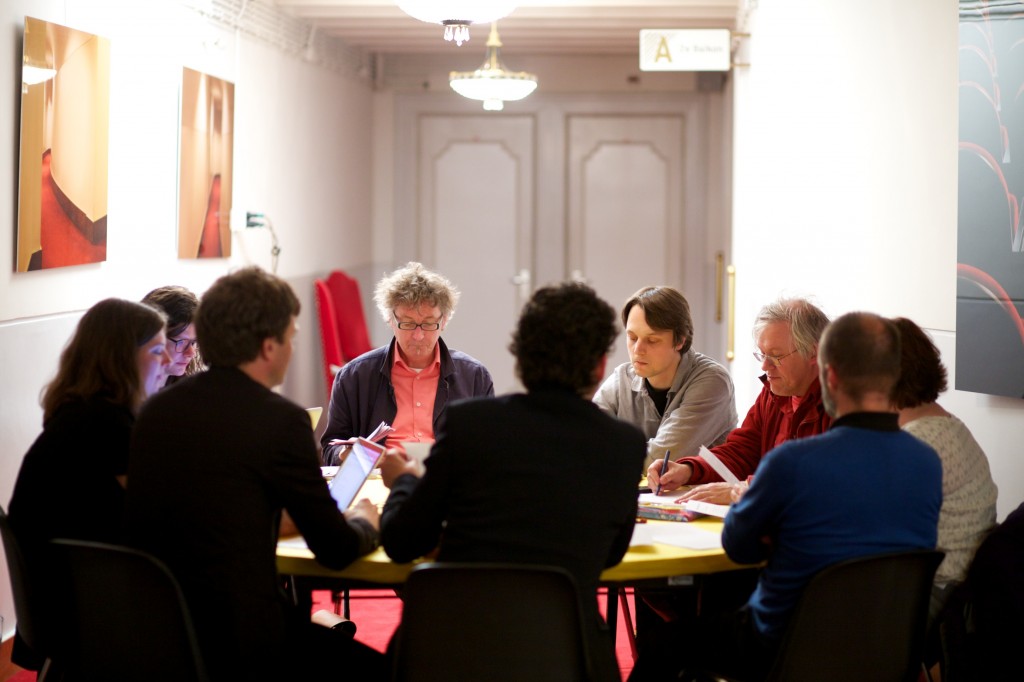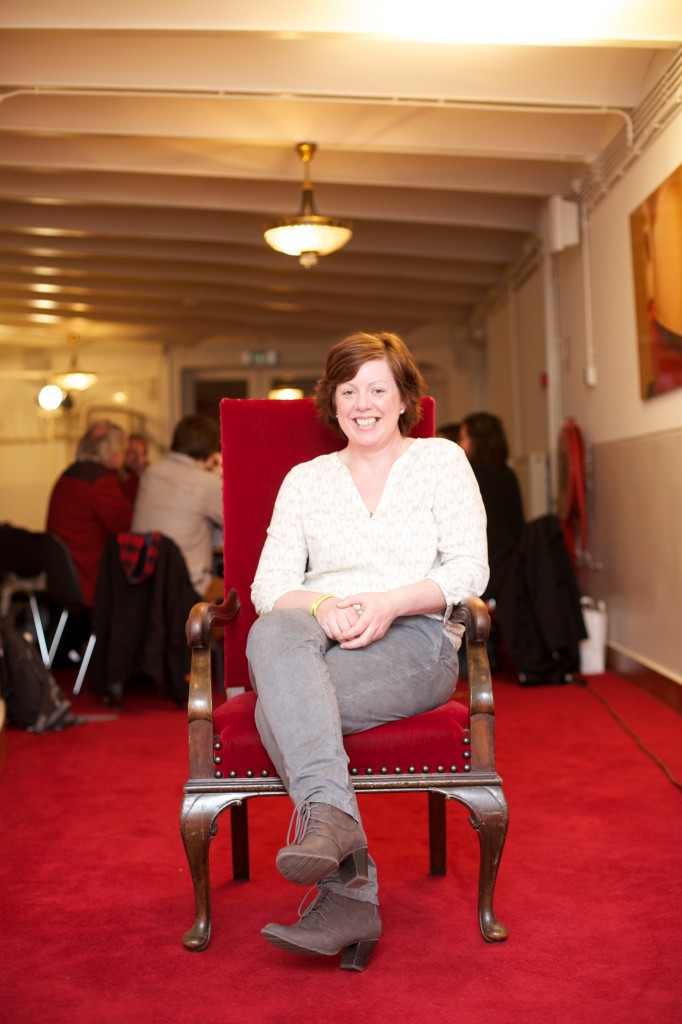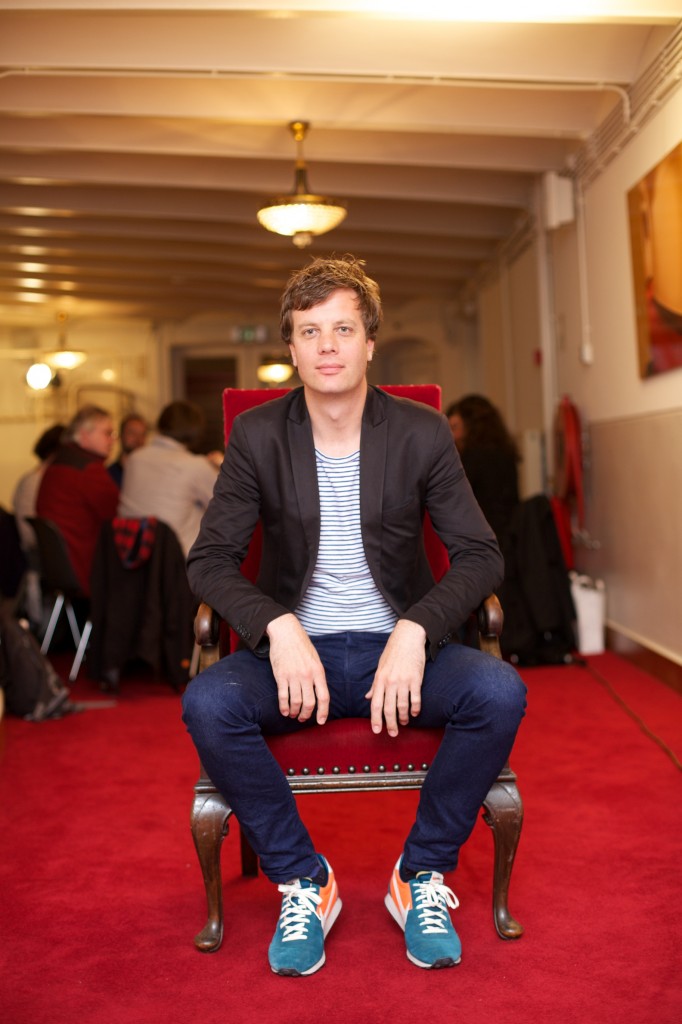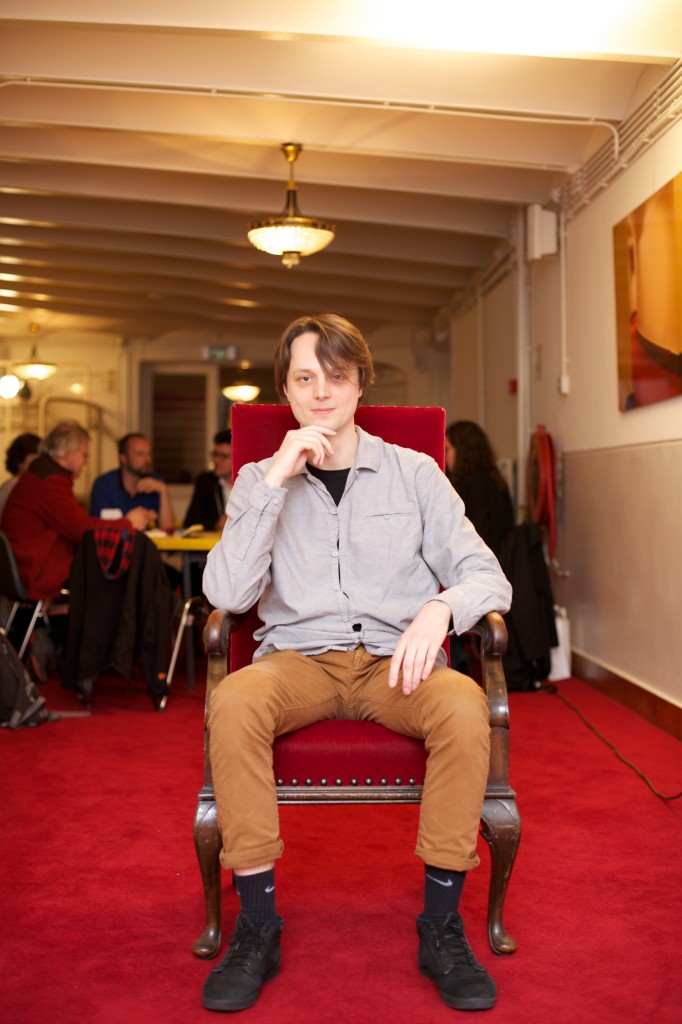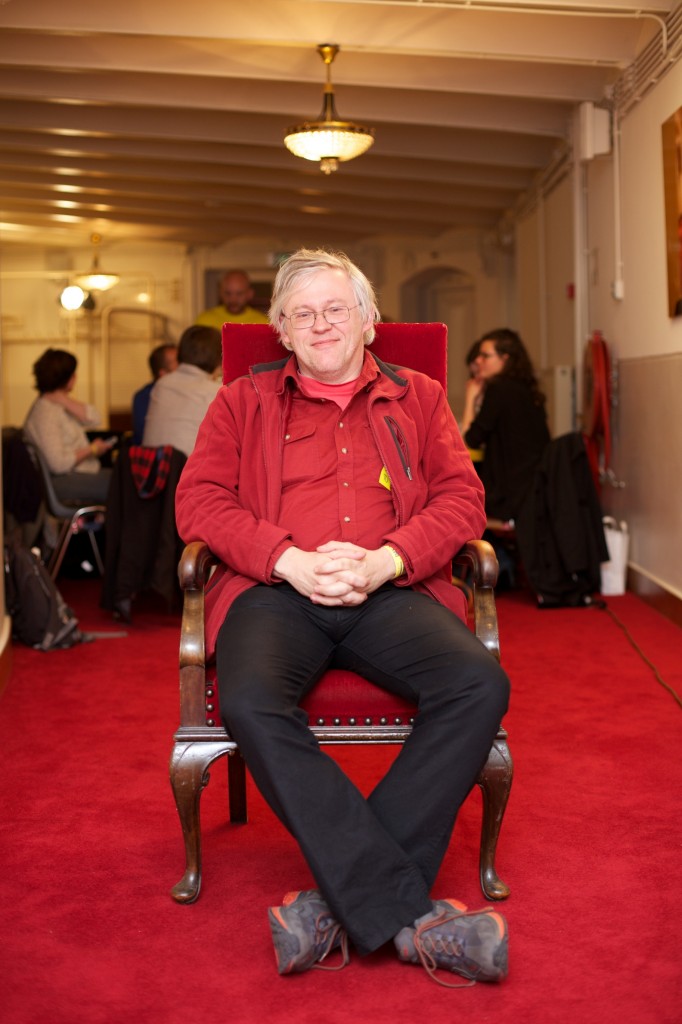Session 1 – Expertmeeting at What Design Can Do
May 16th, 2013
Kick off public research on social design by The New Insitute, Twynstra Gudde and the DOEN foundation.
This private round table session was meant to find terms to address the aspects we want to study and clarify during the project. As a starting point we consider social design as a set of motivations, goals, means and methods that can be part of various design disciplines. Our goals for this meeting are:
– To clarify and unpack the term ‘social design’.
– What entails good social design in your design field?
– What are, according to you, the conditions that are vital for its success?
Participants
Kars Alfrink (KA) – game designer with a focus on games for social change. More info.
Emer Beamer (EB) – social innovator and educator, initiator of various projects and companies that have social design as their core-business. More info.
Alastair Fuad-Luke (AF) – professor in emerging design practice at the School of Arts, Design and Architecture at Aalto University in Helsinki. Author of The Eco-Design Handbook and an activist. More info.
Tabo Goudswaard (TG) – social designer who develops artistic strategies for (wicked) societal issues. More info.
Pieter Jan Stappers (PJS) – co-author of Convivial Toolbox, design professor at the Faculty of Industrial Design Engineering of the Delft University of Technology. More info.
Moderation
Andre Schaminée (AS) – Geen Kunst // Twynstra-Gudde
Klaas Kuitenbrouwer (KK) – The New Institute
Documentation
Katía Truijen, Flora van Gaalen – The New Institute
Photography
Sebastiaan Ter Burg
To Emer Beamer: What skills and attitudes does a designer or artist need in order to be an effective social designer?
EB: You ask specifically for artists or designers, but anybody can be a social designer. Important characteristics: Humility: willingness to listen, really look with open mind. Prepared to see things that other people don’t notice. You’re looking for patterns. Extreme listening! Deep listening. Reference: Paul Polak: listen listen!
Don’t put your desire on the forefront.
Ethics: Working on diverse *parabases. It’s important to note what your responsibility is and you have to be clear about what you can or cannot do.
Creativity: Standard, but true. Show don’t tell. You work on systematic, ‘big’ problems like poverty, education, health. Break it down, make it concrete. If you talk about ‘making a game’ everyone is thrilled, but maybe you’re not talking about the same thing at all. If you have a concept, don’t stay talking, start making it!
Enterpreneurship: be an initiative taker, builder. If you want to make it happen, start building it. Long-term. Have the desire to take it to the end, 3-5 years, and make sure it will continue after you have left.
Interdisciplinary and a communicator. You should desire to make a long term impact. The project/process still needs to function when you leave.
PJS: Realise that you’re not the one to make the change. It’s the people in the project. You show them what’s good for them. Process facilitation. Involve the people themselves and let them contribute their part of the solution. Especially for wicked problems there are no quick solutions. Create stepping stones to reframe the program. Is a process that you manage. It’s not only about listening, but really about engaging and pulling stuff out of people.
AF: is drawing a process spiral. Whoever comes in, goes out of the community at some point and some re-enter during the process. Build a relationship with the community. It’s not about being a designer. Blend in.
TG: Some people in communities are gatekeepers. First approach as a person with empathy.
PJS: People don’t know what a social designer is. People think you choose the colour of a vase.
AS: ‘designer’ is a tricky name! ‘Who does designing?’ has far more hits than ‘who is a designer?’!
KA: Social design is about not putting yourself in the spotlight. Designing for social issues. Sooner or later you have to declare who you are, uncloak. In commercial work it’s almost like a social contract, just get the job done. In social design this seems not possible.
KK: What do you leave at the door in commercial jobs which makes the situation different?
KA: Perhaps social responsibility. Not one thing, cultural identity. Not a clear distinction.
AF: Artists are very good in communicating and recognizing social contextual circumstances. Use acts of provocation or pretend consensus? You can do all. Make an intervention – use diffrent strategies: antagonism, agonism, agreement? (See Chantal Mouffe).
In commercial work you cannot leave assumptions at the door. There is a specific context you work in, that you should know. In social issues, you have to let assumptions go. If you sign a contract with a client, then you abide to their rules. I haven’t (yet) made contracts with communities.
To Tabo Goudswaard: Last year, one of the keynote speakers of WDCD was professor Kees Dorst. He stated that ‘we are faced with new kinds of problems. Ones we haven’t seen before. Ones that are more open, complex, dynamic and networked than ever before’. We call these problems ‘wicked problems’. Kees said that we need people who can approach these wicked problems in ‘methodic, deliberate, considered and innovative ways’.
Tabo, How do you relate to the complexity of wicked problems in order to do effective social design?
TG: When I’m asked to design for wicked problems I start my research on the problem by visiting the location, talking to the people involved, what are their interests, how did it occur, I am looking for the problem behínd the problem. I focus my research on the perception of the problem by the people involved, I choose the behavioural perspective.
My strategie is not to organize and categorize all the different aspects of the problem, actually I look for móre stuff that can be related to the issue. I let the complexity exist as it is and choose from that big problemfield those aspects of the problem that fascinate me and combine them. From that I design a new way of looking at the problem: Frame creation. In that I put my authorship (my egotrip) as an artist. In order to create a frame I’m really enthousiastic about, in that sense that I believe will help the people involved and fits the situation. With that enthousiasm I try to involve the (possible) stakeholders in that new frame. Something I don’t know the exact outcome from, but for which I have a intuïtive notion new possibilities for the problem can be discovered. ‘Possible future’. I try to engage people in showing them how my frame has impact on the problem but above all in creating a new promise: This might be fantastic and I am part of this/I can influence this. By doing so, participants can play a collective role in the outcome, their expertise on the issue is used in a constructive way and it creates collective support for the outcome.
AS: Sometimes wicked issues are facts of live. What I notice as consultant, wicked problems are so complicated that people fall back on known things/approaches. How do you get them with you to the new frame?
TG: Empathy, research how people experience the problem. I don’t know for sure if it will work, but it might be interesting. We’re in it together and we’re gonna find out.
AS: Why do they follow you? Charisma?
PJS: Dó they follow you?
AF: No they join you.
TG: they know more about it then I do.
KK: Is the right word that you are a catalyst? Not the leader, messiah, but start of alternative way of looking at things. You ask them to ‘fall forward’ rather then to fall back.
TG: It’s crucial to make people co-authors.
AS: you have multiple stakeholders. Is there a difference in getting people to join you if you talk about society/different stakeholders? Everyone needs to change/adapt, seems hard.
TG: there are different ways how people can be involved. For the people it’s their live. For city council: they stop at 17 o’clock. So everyone needs a different approach.
EB: Sometimes it feels a bit manipulative. Because I feel what they want. I reformulate things to match different agenda’s.
AS: Is manipulation part of social design?
PJS: It’s not ‘manipulating’ it’s ‘facilitating’. Not pushing your ideas through. An important skill of social designer
TG: Designer is the creator of the frame, so I take responsibility for it. It’s a gamble. Intuitive feeling. I take the heat if things go wrong. Sometimes that helps to get people out of their comfort zone.
AS: Multi-stakeholder complexity
PJS: This is always the case in wicked problems.
AF: we/I, humility! Mutualisation. Making things mutual. You can be me. Mutual societies, 19th century. Individuals and society. Possibilities. Every circumstance in live has possibilities. It’s not healthy to make everything a problem.
To Kars Alfrink: What are the kind of values that need to be shared between client and designer in order to do effective social design?
KA: Specific values depend on the space you’re working in. How do you get to the point that you can have shared values. It’s important to understand peoples values, although this is time consuming. Also talk about your own values. Get a sense of the landscape.
KK: How do you approach if your client is really from a different framework?
KA: It doesn’t help framing it as a problem because people’s agenda’s come to the forefront. For example: the meat industry. Sometimes agenda’s are so different that you are not able to do much, but you can always explore new directions. The goal is maybe not to solve the problem, but to provide new insights.
AS: Aiming at mutual gains?
KA: You are part of the collective: it can be in everybody’s interest.
KK: It’s about finding the mutuality.
KA: Design can provide good reframing of situation. Step out of their traditional roles and act in a different way.
AS: How do you make sure you do not become the center point where all things end?
KA: That’s the question. Interactions happens around you. Plenty of conflict is going on in which I’m often not involved at all.
KK: The word ‘play’ is very important.
KA: Play, ambiguity. Often one thing cannot mean 2 things at the same time, in my work it can. Another important notion: Show and don’t tell.
AF: The world is a tricky place for one view. Create a situation in which people agree to disagree, respect diversity. Design can fertilize this.
PJS: Leap from present to the future and belief in possible futures. Storytelling, gameplay, stories. Get people to understand what the world could be looking like.
AF: We modify the present because of ideas of the future. The social side of design orientates on the present. It affects possibilities of the future. Companies are orientated on the future. I hate ‘Future ™’.
PJS: Connection to the present is essential. Exploring different possible futures. Those skills should be very strong developed in ‘designers’. I’m not sure if they are per se the ones to have the creative ideas.
AS: Ambiguity is more common among artists, not in business. How do you make them comfortable with that?
AF: It’s about curiosity, arousal, novelty. Ambiguity is linked to these notions that are very human.
KA: Tap into that curiosity. It plays a central role in prototypes. It shows the ambiguous way things work.
PJS: Let’s not turn design into mythology! Even organizing a child’s party is ‘design’. But no one sees this as a way to tackle wicked issues. They feel they need technical skills.
EB: The challenge is how to get people on board. An example from Butterfly Works: Bring convincingly not finished products to the table: to show it’s real, but that they can still influence it.
To Pieter Jan Stappers: Within the field of social design, what aspects of co-creation are effective to articulate in methods, and which aren’t?
PJS: What is social design?
3 areas of discourse:
1. solving societal problems, global warming, obesity
2. awareness that we design things to work between people (a lot of design thinking aims on individual. Social design is more contextual.) Design focused on experience of the individual, it is now used for a multiple people context.
3. designing with twitter (I’m glad we didn’t discuss this one)
KK: People also talk about social design as participatory design
PJS: This is not social design, this is participatory design. There is also ‘service design’. There is an enormous debate going on, using different definitions. How can tools and methods help? They’re there to help you conduct a process, to give you foot holes to not slip. Without empathy, tools won’t help you. There are a lot of methods to develop common language, build group feeling, how to bring values to their own eyes.
There are loads of methods and tools. So, instead of ‘methods’ as such, focus on roles and responsibilities. For example a research in a hospital: ‘what soap could better be used?’ Participatory design with nurses, cleaners etc. After 17 sessions no new ideas came about, but they kept on having these meetings. The gain was: people that participate become activists in their world. This togetherness makes it possible that we keep improving our situations.
The idea is that a 24 year old cannot design for elderly, but everyone can design for kids. We’re thinking in realms and experience based sectors. It’s about handing over control. If you have a pencil, it doesn’t mean that you can draw, but you can show your ideas.
I’m in favour of a broad variety of design methods.
Context mapping: end-users participate as experts of their experience. Designers have a problem with bringing people in. Expert of experience. Not only understand the situation.
KK: When is the work done?
PJS: when people can carry on themselves? Sometimes you have to take it away (if funding ends etc.)
TG: Everyone has a different responsibility. If everyone is engaged you can go out.
AF: In commerce you would say: do not enable the clients to much: then you’ll never get another job… In social communities it’s key. Indigenous communities: every act of a person affects everybody else. It’s a live cycle. You’re cultivating/gardening spirits/people.
AS: one question a bit of topic: social process design might not be that interesting to all designers. How do we select the ‘right’ designers?
Empathy measurement:
EB: you smell them!
AF: I asked a design student how many roles she played in a design process. She identified 59 roles, 12 were design. Cup-of-tea maker, hugger, not just the role of the designer.
KA: you need designers of different temperaments, every view can be significant.
To Alastair Fuad-Luke: How to capitalize the results of social design? How do you measure impact?
AF: Open source. Design capitalia: see my blog. Capital has different ‘meanings’: living, social capital, commercial capital etc. You have to know where you started, benchmark to relate to where you are now. Wider: is it about social innovation. This is what ‘social innovators’ want: Look at macro level.
– meet social needs
– new social relationships
– create new social colabs
– for social public good
– transform the present
– system change
– socially conscious, etc. The list is long.
We are framing something. We have an intention. We have strategies, antagonism, details, content, management, organization. What kind of transformation do we want? A mutual journey with designing. What do you want to protect, diminish, etc. Increase social bonding, grow social capital. Design devices, they do something, between I and we.
A new school is an output, but what is the outcome. How does it lead to new possibilities to deal with wicked problems? You need to start framing what you want. Results, how to capitalize results, good intentions, best devices, processes, negotiations between I and we, outputs, but what is the outcome? A new capacity to deal with wicked problems. Start framing what results you might be looking for, without staying there.
It is a tricky terrain. Don’t create the brief on your own. Tabo, if you create a new frame, you create your own brief.
But sometimes, social designers don’t have a clear brief. Afterwards they need to reflect. We made a questionnaire, base-lining, helping social designers in retrospective to check. Turned out that they didn’t know what they were doing it, if they had known, they could have done better.
Measure qualitative / quantitative, frame what we are and what we are not doing.
Relationality:
– ideology to design
– how do we design together, diabolical, ideology, amateur designers,
– alternative economies and new livelihood
– outsourced knowledge creating
We outsourced knowledge creation to the rest of the world. Feels as a minority sport. Take back economic capital: change to humanly capitalize.
Our commons, I and we. How is Europe talking about social innovation? Meet social needs, roles, collaboration, new answers. Transformatory.
KK: Important what terms you use to what people.
AF: New words take people out of their known realm. Interruption. Contesting the regime of representation (Ranciere).
KK: Like the use of the word capital. Adding adjectives, use the vehicle to charge it differently. Retraining the world.
AF: Reclamation of words. See book: Sustainist Design Guide
KA: What place do ethics have in design courses. As a social designers you are embedding an ethical discourse.
AF: Not as much as they should.
KA: It would be key to change that.
PJS: Designers don’t like to read.
KA: You need pragmatic ethics!
AF: Trust yourself and trust others.
*****

